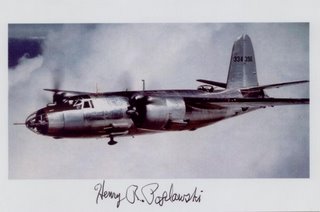LtCol Henry R. Poplawski USAF(Ret) 1914-2015
 Henry Poplawski wanted to be a pilot from his teenage days. He flew kites and model airplanes that he made. Reaching his goal was a slow process. His parents were Polish immigrants and he was the second son of three boys and four sisters. He lost both his parents by the age of 12 and was living with his younger brother and sister at his oldest sister’s house. Hoping to go to college after high school was just a dream,but he had help from an Uncle who gave him $200.00 to start the first semester, class of 1939 in his hometown at Worcester Polytechnic Institute in Massachusetts.
Henry Poplawski wanted to be a pilot from his teenage days. He flew kites and model airplanes that he made. Reaching his goal was a slow process. His parents were Polish immigrants and he was the second son of three boys and four sisters. He lost both his parents by the age of 12 and was living with his younger brother and sister at his oldest sister’s house. Hoping to go to college after high school was just a dream,but he had help from an Uncle who gave him $200.00 to start the first semester, class of 1939 in his hometown at Worcester Polytechnic Institute in Massachusetts.He worked at the college under a government program to pay for his freshman year. He did not have any money to continue and had to drop out. He enlisted in the Army Air Corps with his younger brother and went to the Air Corps Technical School and completed the airplane mechanic course and the radio operator and repair course. His next objective was a two year college equivalency exam to get an appointment as a flying cadet. He got his wings and was commissioned as a second lieutenant in the Army Air Corps in 1939.
From here on his flying life moved on swiftly. His first assignment was to Middletown Air Depot, Pennsylvania. He flew all over the USA and in all kinds of different airplanes. Some were old like the Glenn L. Martin Company first all metal bomber the B10. The B-10 came from Brazil for repairs and it is now at the Air Force Museum, Dayton, Ohio. Before the US came into WWII, the US Air Corps wanted a way to help the British in Africa. Pan American Air established an African division named PAAAfrica. The pilots for this pseudo airline came from the Air Corps. He was an assigned as a volunteer plus four other pilots and sent to Africa by a Pan American flying boat.There they pioneered an airline across middle Africa; there was a war going on in North Africa. They extended the airline over Arabia, India all the way to China. After 13 months the expanded airline was militarized and the US was totally involved in WWll.
When he came to work for the Glenn L. Martin Company in October 1942, after 13 months flying in Africa for Pan American Airways, the company was in full production of the B-26, the A-30, and the PBM-3. Although most of his test flying was on the B-26 Marauder, he did fly the other aircraft through the end of World War 11.
When WWII ended he went back to college at the University of Southern California and received his BE in aeronautical/mechanical engineering in 1948. After graduation he returned to Glenn L Martin as an aeronautical engineer in customer service. With the war in Korea he was recalled in 1951 to active duty to fly Glenn L. Martin made B-29s. The Training Command changed his orders and he went to Lowry AFB, Denver, Colorado to setup the Guided Missile Training School,where he eventually became the Director. He trained mechanics and operators for the Glenn L. Martin pilot less missiles; the Matador and the Mace.
His career field changed from flying to air/aerospace technical intelligence. His next duty was a four-year assignment to CIA in Washington, DC. He went back to the Air Force for a field assignment in Tokyo, Japan. They kept track of what the other side was doing and they kept their eyes on us. He retired from the Air Force in 1966 with 20 years of active duty and 12 years in the reserves. He changed from the uniform to Civil Service and stayed in the same job,retiring from Civil Service in 1977, at Wright-Patterson AFB.


<< Home